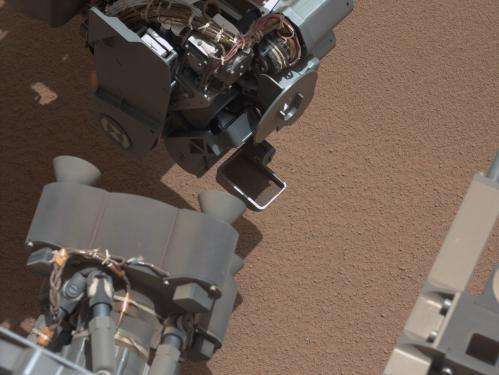This image from the right Mast Camera (Mastcam) of NASA's Mars rover Curiosity shows a scoop full of sand and dust lifted by the rover's first use of the scoop on its robotic arm. In the foreground, near the bottom of the image, a bright object is visible on the ground. The object might be a piece of rover hardware. This image was taken during the mission's 61st Martian day, or sol (Oct. 7, 2012), the same sol as the first scooping. After examining Sol 61 imaging, the rover team decided to refrain from using the arm on Sol 62 (Oct. 8). Instead, the rover was instructed to acquire additional imaging of the bright object, on Sol 62, to aid the team in assessing possible impact, if any, to sampling activities. For scale, the scoop is 1.8 inches (4.5 centimeters) wide, 2.8 inches (7 centimeters) long. Image credit: NASA/JPL-Caltech/MSSS
NASA officials say the Curiosity rover has made its first scoop of the surface of planet Mars and has detected a bright object on the ground.
Officials said in a news release Monday that they suspect the object might be a part of the six-wheeled rover, but they won't sample or scoop anymore until they figure out what it is.
The Curiosity has already beamed back pictures of bedrock that suggest a fast-moving stream once flowed on the planet.
Video: This video clip shows the first Martian material collected by the scoop on the robotic arm of NASA's Mars Curiosity rover, being vibrated inside the scoop after it was lifted from the ground on Oct. 7, 2012. The clip includes 256 frames from Curiosity's Mast Camera, taken at about eight frames per second, plus interpolated frames to run at actual speed in this 32-frames-per-second version. The scoop was vibrated to discard any overfill. Churning due to vibration also serves to show physical characteristics of the collected material, such as an absence of pebbles. The scoop is 1.8 inches (4.5 centimeters) wide, 2.8 inches (7 centimeters) long. Credit: NASA/JPL-Caltech/MSSS
The rover landed Aug. 5 and is on a two-year, $2.5 billion mission to study whether microbial life could have existed on Mars in the past.
Today's Mars is a frozen desert, but previous geological studies suggest it was once warmer and wetter.
Copyright 2012 The Associated Press. All rights reserved. This material may not be published, broadcast, rewritten or redistributed.
























